Outreach and Education Materials
The NRC staff maintain outreach materials that can be used to educate stakeholders
about safety culture and  the NRC's Safety Culture Policy Statement. In addition to the Federal Register Notice containing the Final Safety Culture Policy Statement, a brochure and poster are also available.
the NRC's Safety Culture Policy Statement. In addition to the Federal Register Notice containing the Final Safety Culture Policy Statement, a brochure and poster are also available.
- Federal Register Notice English Version | Spanish Version
- Brochure (NUREG/BR-0500) – available in English, Spanish, and Printer-Friendly Versions
- Poster (11x17)
On this page:
- NRC-Developed Safety Culture Case Studies
- Safety Culture Journey
- Safety Culture Trait Talk
- Safety Culture Infographics
- Safety Culture Educational Resource
- Safety Culture Outreach Activities
- Safety Culture Policy Statement Outreach Effectiveness Survey
- U.S. NRC Safety Culture Oversight, Paper presented at the International Atomic Energy Agency, Vienna, Austria 2016
- Safety Culture during Decommissioning: 2017 Regulatory Information Conference (RIC)
- Safety Culture in the ROP Training Resource – Text Version
- U.S. NRC Safety and Security – Policy and Oversight
- U.S. Nuclear Regulatory Commission's Approach to Safety Culture
- IAEA Harmonization of Safety Culture Framework
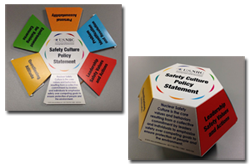 NRC staff also have pop-ups available (pictured to the right), which are convenient desktop references for the Safety Culture Policy Statement definition and traits. Please contact safety culture staff for more information.
NRC staff also have pop-ups available (pictured to the right), which are convenient desktop references for the Safety Culture Policy Statement definition and traits. Please contact safety culture staff for more information.
NRC-Developed Safety Culture Case Studies
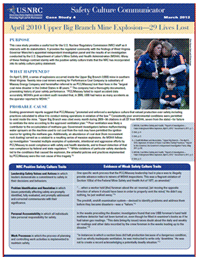
The NRC has developed Safety Culture Case Studies to provide real-life events where review of the circumstances surrounding the event and the results of the investigations found clear examples of the role that safety culture played in contributing to or in lessening the causes and consequences of the event.
These case studies are learning tools. Those responsible for regulating or using radioactive material in a safe and secure manner should not become complacent and should be open to learning from the mistakes and the problems others have faced in an effort to prevent recurrences. The case studies that will be selected for this initiative represent a breadth of industries, including energy, medical, and transportation.
The NRC has also developed a Safety Culture Case Study User Guide to help individuals and organizations use the various case studies more effectively, providing them with a better understanding of why a strong safety culture and safety-first focus are critically important. It is recommended that you review the User Guide prior to reviewing the case studies.
Currently available Case Studies:
- Collision of Two Washington, D.C. Metropolitan Area Transit Authority Metrorail Trains
- US Airways Flight 1549: Forced Landing On the Hudson
- Partial Collapse of the Willow Island Cooling Tower
- Upper Big Branch Mine Explosion – 29 Lives Lost
Additional case studies are under development and will be added as they are completed.
Safety Culture Journey
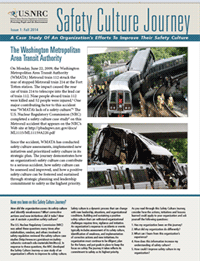
After reading the Safety Culture Case Studies describing how an accident occurred due, in part, to a weak safety culture, the NRC was asked: "What happened next?" Readers wanted to know how the organization assessed safety culture, what corrective actions and new initiatives they took, and how they began to make improvements in safety culture. The NRC developed Safety Culture Journey in response to these questions. This educational tool reflects an organization's journey towards a positive safety culture.
Safety Culture Trait Talk
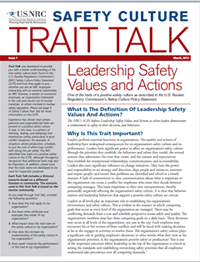
Trait Talk is an educational tool developed to provide a better understanding of the nine safety culture traits found in the NRC's Safety Culture Policy Statement. Each Trait Talk is a four-page brochure that provides more information on a specific safety culture trait by describing why the trait is important for a positive safety culture, examples of behaviors and attitudes associated with the trait, and scenarios illustrating how the trait may play a role in an organization's safety culture.
- Trait Talk, Issue 1: Leadership Safety Values and Actions
- Trait Talk, Issue 2: Work Processes
- Trait Talk, Issue 3: Questioning Attitude
- Trait Talk, Issue 4: Problem Identification and Resolution
- Trait Talk, Issue 5: Environment for Raising Concerns
- Trait Talk, Issue 6: Effective Safety Communication
- Trait Talk, Issue 7: Respectful Work Environment
- Trait Talk, Issue 8: Continuous Learning
- Trait Talk, Issue 9: Personal Accountability
Safety Culture Infographics
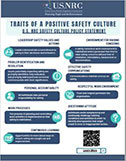
NRC staff is developing a series of infographics to communicate the NRC's Safety Culture Policy Statement and Traits. These infographics can be printed and posted, and used to initiate conversation on the importance of a positive safety culture.
Safety Culture Educational Resource
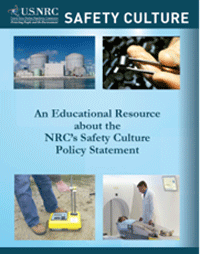
The Safety Culture Educational Resource on the Safety Culture Policy Statement was developed as a training tool for licensees, vendors and Agreement States. This resource includes the nine Trait Talks, the Metro Case Study and the Metro Journey (all previously individually published on the Safety Culture Web page) along with study questions and the Policy Statement FRN. This resource provides the licensees with a comprehensive understanding of the policy statement and how they can put its principles into action in their daily activities.
Safety Culture Outreach Activities
As part of ongoing outreach activities associated with the Safety Culture Policy Statement, NRC staff give presentations about safety culture at internal and external meetings and conferences. A table listing outreach activities from 2010 to the most recent quarter are included in the following links:
- Safety Culture Policy Statement Outreach Table Jan 2010 – Dec 2011. (4 page(s), 8/4/2014)
- Safety Culture Policy Statement Outreach Table Jan 2012 – Dec 2013. (4 page(s), 8/4/2014)
- Safety Culture Policy Statement Outreach Table Jan 2014 – Dec 2014 (4 page(s), 3/19/2015)
- Safety Culture Policy Statement Outreach Table Jan 2015 – Dec 2015 (3 pages), 1/21/2016
- Safety Culture Policy Statement Outreach Table Jan 2016 – Dec 2016
- Safety Culture Policy Statement Outreach Table Jan 2017 – Dec 2017
- Safety Culture Policy Statement Outreach Table Jan 2018 – Dec 2018
- Safety Culture Policy Statement Outreach Table Jan 2019 – June 2019
- Safety Culture Policy Statement Outreach Table Jan 2019 – Dec 2019
- Safety Culture Policy Statement Outreach Table Jan 2020 – Dec 2020
- Safety Culture Policy Statement Outreach Table Jan 2021 – Dec 2021
- Safety Culture Policy Statement Outreach Table Jan 2022 – Dec 2022
Safety Culture Policy Statement Outreach Effectiveness Survey
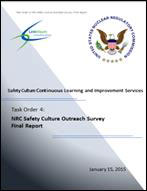 The NRC engaged LinkVisum Consulting Group to conduct a survey to assess the effectiveness of the NRC Safety Culture Policy Statement education and outreach for its licensees and the licensees of Agreement States. The survey questions, methodology, results, and recommendations are included in the NRC Safety Culture Survey Effectiveness Outreach Final Report and Supplement.
The NRC engaged LinkVisum Consulting Group to conduct a survey to assess the effectiveness of the NRC Safety Culture Policy Statement education and outreach for its licensees and the licensees of Agreement States. The survey questions, methodology, results, and recommendations are included in the NRC Safety Culture Survey Effectiveness Outreach Final Report and Supplement.
- NRC Safety Culture Policy Statement Outreach Effectiveness Survey Final Report
- NRC Safety Culture Policy Statement Outreach Effectiveness Survey Supplement
U.S. NRC Safety Culture Oversight
In February 2016, the U.S. NRC presented a paper at a conference on The Thirty Years of Safety Culture, at the International Atomic Energy Agency (IAEA), Vienna, Austria. ABSTRACT: The NRC recognizes that it is important for all organizations performing or overseeing regulated activities to establish and maintain a positive safety culture commensurate with the safety and security significance of their activities and the nature and complexity of their organizations and functions. The NRC's approach to safety culture is based on the premise that licensees bear the primary responsibility for safety. The NRC provides oversight of safety culture through expectations detailed in policy statements, safety culture assessor training for NRC inspectors, the oversight processes, and the Allegations and Enforcement Programs.
Safety Culture during Decommissioning: 2017 Regulatory Information Conference (RIC)
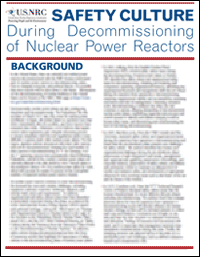 Maintaining a strong safety culture during the decommissioning of a nuclear power plant is a challenge faced by a growing number of licensees. As more plants begin preparation for decommissioning, it is important to ensure that safety remains a priority. Changes in staffing and work processes, along with new financial and political pressures, create an environment at risk for emerging safety concerns. It is essential that safety culture continues to be fostered and maintained throughout this phase. The panel at the 2017 RIC, Diane Sieracki (NRC), Stewart Yuen (Dominion – Kewaunee), Coley Chappell (Entergy – Vermont Yankee), and Andrew Orrell (IAEA), provided presentations on safety culture during decommissioning. An educational resource was also provided.
Maintaining a strong safety culture during the decommissioning of a nuclear power plant is a challenge faced by a growing number of licensees. As more plants begin preparation for decommissioning, it is important to ensure that safety remains a priority. Changes in staffing and work processes, along with new financial and political pressures, create an environment at risk for emerging safety concerns. It is essential that safety culture continues to be fostered and maintained throughout this phase. The panel at the 2017 RIC, Diane Sieracki (NRC), Stewart Yuen (Dominion – Kewaunee), Coley Chappell (Entergy – Vermont Yankee), and Andrew Orrell (IAEA), provided presentations on safety culture during decommissioning. An educational resource was also provided.
|
|
Educational resource (NRC) | "Safety Culture during Decommissioning" | |
|
|
Diane Sieracki (NRC) | "Safety Culture and Decommissioning" | |
|
|
Stewart Yuen (Dominion) | "Maintaining a Strong Safety Culture after Shutdown" | |
|
|
Coley Chappell (Entergy) | "Safety Culture in Decommissioning: Vermont Yankee Experience" | |
|
|
Andrew Orrell (IAEA) | "Safety Culture and the IAEA International Perspectives" |
Safety Culture in the ROP Training Resource – Text Version
NRR developed an on-line training module for NRC Inspectors on Safety Culture in the Reactor Oversight Process (ROP). The content has been converted into a word document. This document: 1) defines safety culture; 2) discusses why safety culture is important; 3) describes the safety culture cross-cutting aspects in the ROP; and 4) describes the treatment of safety culture in the ROP baseline and supplemental inspection programs. Further, this document includes discussion of the Safety Culture Policy Statement and several case studies.
U.S. NRC Safety and Security – Policy and Oversight
In November 2017, the U.S. NRC provided a paper, USNRC: Safety and Security – Policy and Oversight, for an International Conference on Physical Protection of Nuclear Material and Nuclear Facilities at the International Atomic Energy Agency (IAEA), Vienna, Austria. This paper discusses how the NRC addresses safety and security for NRC licensees, applicants and vendors through policies, programs, and regulations, including the Safety Culture Policy Statement (SCPS), the Reactor Oversight Process (ROP), and the Allegation and Enforcement programs. This paper also describes how the SCPS addresses both safety and security, and how safety and security performance is assessed through the ROP for operating power reactors, and through the Allegation and Enforcement programs for material users and vendors, as well as operating power reactors. Finally, this paper includes illustrative examples of security/safeguards inspection findings tagged to ROP safety culture aspects, and security/safeguard findings resulting in Alternative Dispute.
U.S. Nuclear Regulatory Commission's Approach to Safety Culture
Diane Sieracki, NRC's Senior Safety Culture Program Manager, provided this Safety Culture Webinar for the National Association of Employee Concerns Professionals on July 22, 2020. This webinar presentation, "U.S. Nuclear Regulatory Commission's Approach to Safety Culture" includes a discussion of NRC's current safety culture oversight processes, current status of Agency safety culture activities and an update on current international safety culture activities.
IAEA Harmonization of Safety Culture Framework
The IAEA published the Harmonization of Safety Culture document in June, 2020. This document is a culmination of several years of work by the NRC and members countries, along with the Institute of Nuclear Power Operations (INPO) and the World Association of Nuclear Operators (WANO) and utilizes the NRC’s Safety Culture Policy Statement safety culture traits as a basis. This document allows for common language globally when discussing safety culture.
Page Last Reviewed/Updated Monday, December 01, 2025
Page Last Reviewed/Updated Monday, December 01, 2025

